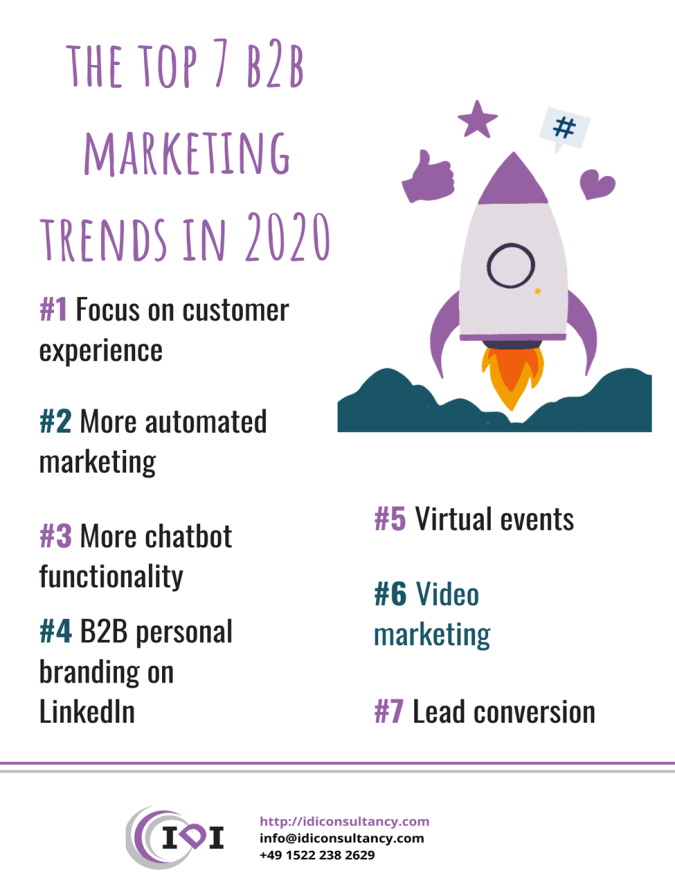B2B marketing is constantly changing. We’ve already seen a few big shifts in recent years, like the increase in inbound marketing, and there’s sure to be many more changes to come.
B2B marketing trends 2020 are likely to keep up with B2C marketing, which they have traditionally lagged behind. The main focus will be on improving the overall customer experience as they interact with your business along the buyer journey.
Let’s dive into the top 2020 marketing trends in B2B.
7 B2B marketing trends 2020 to embrace
These are the main B2B marketing trends to embrace in 2020 if you want to keep up with the times and outrun your competitors.

1. Focus on customer experience
B2B marketers are going to focus a lot more on improving customer experience throughout the buyer journey. There are many benefits of better customer experience, including increased revenue and customer loyalty.
Improvements in customer experience have been said to reduce customer churn rate by 10 to 15%. It also increases the win rate of offers by 20 to 40% and lowers the cost to serve by 50%.
Speed, convenience, knowledgeable help and friendliness are the most important customer experience traits to focus on.
2. More automated marketing
44% of B2B brands have dedicated marketing automation platforms, and it’s set to increase. Marketing automation involves using software to automate certain marketing activities. Many B2B brands use it for tasks like email marketing, social media posting and ad campaigns. It’s not just great for efficiency, but it also provides a more personalized experience for customers.
Automation is already used for targeting and segmentation, mapping intent data across the customer journey, and automatically serving up ads. It’s now going to be used more for gathering data to create even more personalized experiences.
According to a report by Forrester, it’s 2020 outlook points out 62% of global B2B marketing decision-makers are increasing their data management investments.
3. More chatbot functionality
Chatbots are another form of automation that we’ll start seeing more of. Bots are being used to generate and nurture leads, sort out content relevant to an account, and many other functions, which takes care of redundant tasks.
80% of businesses are expected to have chatbot automation by 2020, with 58% of companies currently using chatbots being B2B. According to Lauren Foye, by 2022, banks will be able to automate up to 90% of their customer interaction using chatbots. Showing that it’s definitely something to start considering, even though the technology is still far from perfect.
Voice bots are also likely to rise as they are much more engaging compared to chatbots while also improving Voice Search SEO for companies.
4. B2B personal branding on LinkedIn
More than 50% of all B2B social traffic comes from LinkedIn, and 80% of leads are derived from LinkedIn.
There is going to be a lot more emphasis on B2B companies implementing personal branding on LinkedIn in the hope to attract and convert prospects into clients. Personal branding allows companies to add a human touch to their B2B content strategy. This not only makes your brand more interesting but also more appealing to potential customers.
Business executives are starting to use their personal LinkedIn profiles to regularly connect with their audience, showing valuable information, tips and advice. They’re setting themselves up to be thought leaders in their industry, and as a result, getting potential customers to trust them and their brand.
The stronger your personal brand, the more effective your B2B marketing strategy on LinkedIn will be.
5. Virtual events
While the COVID-19 pandemic definitely created a massive shift towards more virtual events, this 2020 B2B marketing trend was already on the cards. Virtual events in the form of seminars, product training, and leadership workshops will remain highly useful for B2B.
Virtual events have been extremely relevant in the B2B space during the pandemic as it’s been the best way to continue connecting with your audience. Video conferencing enables you to interact at a closer level with your leads and persuade them into buying your product by demonstrating its benefits.
You’re also able to connect with more potential customers, spreading across continents and timezones. Because of these many benefits, we’ll be seeing the trend of virtual events sticking around beyond 2020.
6. Video marketing
Video marketing isn’t going anywhere. 70% of B2B buyers watch a video as part of their product research before conversion, showing you how important this form of marketing is in the B2B space.
In 2020, businesses need to create videos with messages targeted for segmented audiences on social media. These messages need to be ultra-targeted and focused on the customer to bring out higher engagement.
Video marketing ideas in the B2B space include explainer videos, how-to videos, tutorials, thought leadership videos or customer testimonials.
7. Lead conversion
As B2B’s content marketing matures, there’s going to be more focus on actual macro conversions. We already know that blogs drive traffic, but this traffic needs to be funneled towards gated content, generating leads.
B2B companies are using more eBooks and guides along with webinars and digital workshops to secure more leads. Content including newsletters, blogs posts and case studies are then leveraged to nurture and convert these prospects.
Are you following the B2B marketing trends?
This year has brought with it many changes in the B2B marketing world, many of which we’re going to see sticking around for a while. A move to digital is no longer a trend, you should already be well versed in the world of digital marketing.
2020 is about fine-tuning your digital presence and taking advantage of newer technologies like AI and automation. Now that you know about the B2B marketing trends 2020, how are you going to adapt your strategy?



